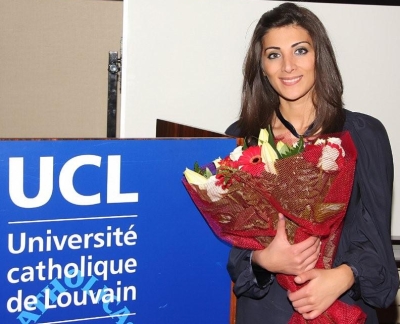

 (AINA) -- For many decades the different types of Syriac script remained classified and named by western scholars along the lines of the different oriental churches, such as the Nestorian, Chaldean and Melkite. This strict church-oriented classification of Syriac, a script widespread in the ancient near east and Asia, has been successfully refuted by Ms. Ayda Kaplan, herself of Assyrian/Syriac origin and a member of the Assyrian/Syriac community in Belgium.
(AINA) -- For many decades the different types of Syriac script remained classified and named by western scholars along the lines of the different oriental churches, such as the Nestorian, Chaldean and Melkite. This strict church-oriented classification of Syriac, a script widespread in the ancient near east and Asia, has been successfully refuted by Ms. Ayda Kaplan, herself of Assyrian/Syriac origin and a member of the Assyrian/Syriac community in Belgium.
Standing in front of a panel of world renowned scholars On the 10th of December at the Catholic University of Louvain in the city of Louvain-la-Neuve in Belgium, Dr. Kaplan successfully defended her 700-paged doctoral thesis titled "Syriac Paleography: The development of a method of expertise on the basis of the Syriac manuscripts of the British Library (Vth-Xth c.)." Paleography is the study of ancient scripts, which includes interpreting, dating and determining the location of a text or inscription.
The disputation ceremony marked the end of eight years of general studies on manuscripts and five years on the Phd for the young scholar. Many people from the Assyrian/Syriac community were present during Kaplan's disputation. Nahro Beth-Kinne, producer of the Assyrian/Syriac Voice radio program in Brussels, commented: "This is certainly historic. To the best of my knowledge, Ayda is the first person of Assyrian/Syriac origin to indulge in this field since Bar Hebraus, the renowned 13th century scholar and church leader."
Through her extensive research, Ayda Kaplan has laid the foundation for a new discipline in Syriac palaeography by developing a new method for the classification of the different Syriac writing systems. Colette Sirat, renowned researcher on Hebrew palaeography from the Sorbonne University, argued Kaplans' new method will facilitate palaeography studies for other scripts, such as Hebrew, Arabic, Armenian and Coptic as well as many other languages.
Instead of denoting different types of Syriac writing systems to different churches, Dr. Kaplan worked out a new division based on the form of the script itself rather than on church divisions. In her thesis, the earliest known form of Syriac script, widely referred to as Estrangelo, with the earliest known fragments dating from the first century AD, is described as "Syriac Monumental." It was a formal kind of script used for monuments and grave inscriptions. The second form of Syriac script, dubbed "Monumental semi-courant" by Dr. Kaplan, displays features of both the formal Estrangelo as well as new features which rendered it to be used in less formal settings. She identifies a third form of Syriac script, naming it "Courant semi-monumental," meaning that the non-monumental features were dominant. The fourth type of Syriac script, known as Serto, displays no features of the monumental script and has some other features which distinguish it from the three other forms.
"I managed to refute the church-oriented classification because I was able to prove the shared use of the Monumental semi-courant script among several oriental churches," explains Dr. Ayda Kaplan. "The former classification along church lines makes no sense when we now know the different churches used the same form of Syriac script."
Her academic achievement has produced several acknowledgements among scholars and she has been included in the prestigious Manumed project, an EU-funded enterprise for the preservation and study of ancient manuscripts from the Middle East and North Africa.

or register to post a comment.